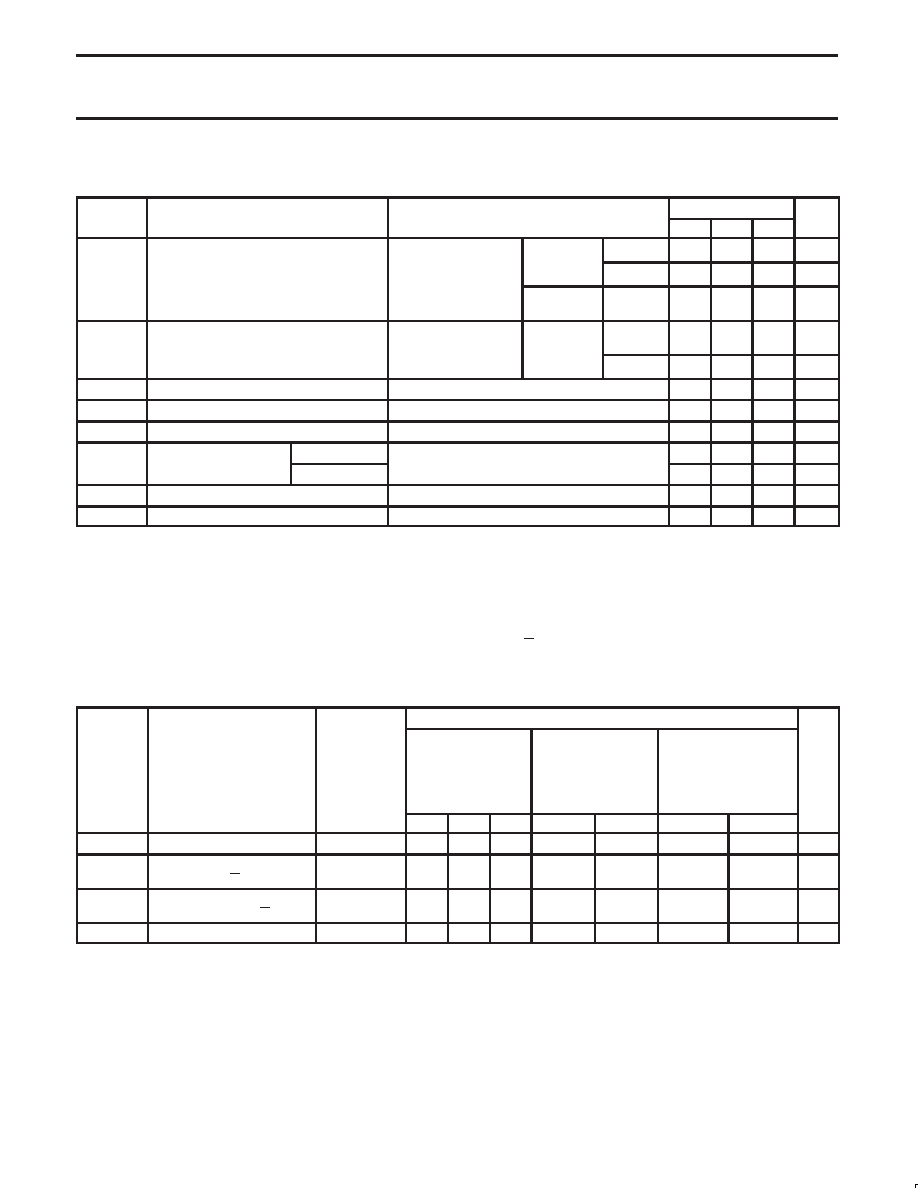- 您現(xiàn)在的位置:買賣IC網(wǎng) > PDF目錄24766 > 935031340623 (NXP SEMICONDUCTORS) F/FAST SERIES, DUAL POSITIVE EDGE TRIGGERED D FLIP-FLOP, COMPLEMENTARY OUTPUT, PDSO14 PDF資料下載
參數(shù)資料
| 型號: | 935031340623 |
| 廠商: | NXP SEMICONDUCTORS |
| 元件分類: | 鎖存器 |
| 英文描述: | F/FAST SERIES, DUAL POSITIVE EDGE TRIGGERED D FLIP-FLOP, COMPLEMENTARY OUTPUT, PDSO14 |
| 封裝: | 3.90 MM, PLASTIC, MS-012AB, SOT-108-1, SO-14 |
| 文件頁數(shù): | 10/12頁 |
| 文件大?。?/td> | 105K |
| 代理商: | 935031340623 |

Philips Semiconductors
Product specification
74F50729
Synchronizing dual D-type flip-flop with edge-triggered
set and reset and metastable immune characteristics
1990 Sep 14
7
DC ELECTRICAL CHARACTERISTICS
(Over recommended operating free-air temperature range unless otherwise noted.)
SYMBOL
PARAMETER
TEST
LIMITS
UNIT
CONDITIONS1
MIN
TY.2
MAX
VOH
High-level output voltage
VCC = MIN, VIH = MIN
IOH = MAX
±10%V
CC
2.5
V
VIL = MAX,
±5%V
CC
2.7
3.4
V
IOH =
–15mA
±5%V
CC
2.0
V
VOL
Low-level output voltage
VCC = MIN, VIL =
MAX,
IOL = MAX
±10%V
CC
0.30
0.50
V
VIH = MIN
±5%V
CC
0.30
0.50
V
VIK
Input clamp voltage
VCC = MIN, II = IIK
-0.73
-1.2
V
II
Input current at maximum input voltage
VCC = MAX, VI = 7.0V
100
A
IIH
High–level input current
VCC = MAX, VI = 2.7V
20
A
IIL
Low–level input current
Dn
VCC = MAX, VI = 0.5V
-250
A
CPn, SDn, RDn
–20
A
IOS
Short–circuit output current3
VCC = MAX, VO = 2.25V
-60
-150
mA
ICC
Supply current4 (total)
VCC = MAX
19
27
mA
NOTES:
1. For conditions shown as MIN or MAX, use the appropriate value specified under recommended operating conditions for the applicable type
and function table for operating mode.
2. All typical values are at VCC = 5V, Tamb = 25°C.
3. Not more than one output should be shorted at a time. For testing IOS, the use of high-speed test apparatus and/or sample-and-hold
techniques are preferable in order to minimize internal heating and more accurately reflect operational values. Otherwise, prolonged shorting
of a high output may raise the chip temperature well above normal and thereby cause invalid readings in other parameter tests. In any
sequence of parameter tests, IOS tests should be performed last.
4. Measure ICC with the clock input grounded and all outputs open, then with Q and Q outputs high in turn.
AC ELECTRICAL CHARACTERISTICS
LIMITS
Tamb = +25°C
Tamb = 0°C to
+70
°C
Tamb = –40°C to +85°C
SYMBOL
PARAMETER
TEST
VCC = +5.0V
VCC = +5.0V ± 10%
UNIT
CONDITION
CL = 50pF,
RL = 500
CL = 50pF,
RL = 500
CL = 50pF,
RL = 500
MIN
TYP
MAX
MIN
MAX
MIN
MAX
fmax
Maximum clock frequency
Waveform 1
105
120
85
75
ns
tPLH
tPHL
Propagation delay
CPn to Qn or Qn
Waveform 1
2.0
3.9
6.0
1.5
2.0
6.5
1.5
2.0
7.0
6.5
ns
tPLH
tPHL
Propagation delay
SDn RDn to Qn or Qn
Waveform 2
2.0
3.0
4.0
5.0
6.5
7.5
1.5
2.0
7.5
8.0
1.5
2.0
7.5
8.0
ns
tok(o)
Output skew1, 2
Waveform 4
1.5
ns
NOTES:
1. | tPLH actual –tPHL actual | for any one output compared to any other output where N and M are either LH or HL.
2. Skew lines are valid only under same conditions (temperature, VCC, loading, etc.,).
相關(guān)PDF資料 |
PDF描述 |
|---|---|
| 935031340602 | F/FAST SERIES, DUAL POSITIVE EDGE TRIGGERED D FLIP-FLOP, COMPLEMENTARY OUTPUT, PDSO14 |
| 935008920112 | TELEPHONE MULTIFUNCTION CKT, PDIP8 |
| 935008930112 | TELEPHONE MULTIFUNCTION CKT, PDSO8 |
| 935008930118 | TELEPHONE MULTIFUNCTION CKT, PDSO8 |
| 935008900112 | TELEPHONE MULTIFUNCTION CKT, PDIP14 |
相關(guān)代理商/技術(shù)參數(shù) |
參數(shù)描述 |
|---|---|
| 9350317 | 制造商:Honeywell / Clarostat 功能描述:SST PRESSURE TRANSDUCERS 制造商:Honeywell Sensing and Control 功能描述:SST PRESSURE TRANSDUCERS 制造商:Honeywell Sensing and Control 功能描述:9350317 SST PRESSURE TRANSDUCERS |
| 935032 | 制造商:JWMILLER 功能描述: |
| 9350-3R1 | 制造商:Johanson Manufacturing 功能描述:VARIABLE CAPACITOR |
| 935040870112 | 制造商:NXP Semiconductors 功能描述:IC MIXER FM IF SYSTEM LP 20-SSOP |
| 9350-4R1 | 制造商:Johanson Manufacturing 功能描述:VARIABLE CAPACITOR 制造商:Johanson 功能描述:VARIABLE CAPACITOR |
發(fā)布緊急采購,3分鐘左右您將得到回復(fù)。